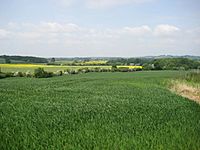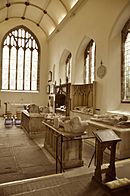Battle of Edgcote facts for kids
Quick facts for kids Battle of Edgcote |
|||||||
|---|---|---|---|---|---|---|---|
| Part of Wars of the Roses | |||||||
 Danes Moor, site of the battle |
|||||||
|
|||||||
| Belligerents | |||||||
| Commanders and leaders | |||||||
|
|||||||
| Strength | |||||||
| Pembroke; estimated 3,000 - 5,000 Devon; estimated 800 - 1,500 |
Estimated 3,000 - 5,000 | ||||||
| Casualties and losses | |||||||
| 168 knights and gentry, ca 2,000 others | unknown | ||||||
The Battle of Edgcote (also called the Battle of Banbury or Battle of Danes Moor) happened on 24 July 1469. It was part of the Wars of the Roses, a series of fights for the English throne. This battle was fought between a Royal army, led by the Earls of Pembroke and Devon, and a rebel army. The rebels were supporters of the powerful Earl of Warwick.
The battle took place about 6 miles (9.7 km) northeast of Banbury in Oxfordshire. The rebels won, which gave the Earl of Warwick control of England for a short time. However, by September, Edward IV of England was back in charge. This meant Warwick was in a similar position as before the battle. He then started planning another rebellion. After Edgcote, the trust between Edward and Warwick was broken forever. Warwick slowly began to support the Lancastrian side.
Historians don't have many detailed records about the Battle of Edgcote. But many old writings and stories mention it. The details about how many soldiers fought, who led them, and how many people died can be different in these accounts. However, these differences don't always mean the stories are wrong. Many Welsh poets wrote about the battle because Pembroke's Welsh soldiers suffered heavy losses.
Contents
Why Did the Battle of Edgcote Happen?
In 1461, Warwick and Edward IV were close friends. They worked together to remove Henry VI from the throne. But by 1469, their friendship had broken down.
Edward married Elizabeth Woodville in 1464. After this, he started to rely more on her family. The Woodville family began to compete with Warwick's family (the Nevilles) for land and important jobs. Edward also stopped a marriage plan between his younger brother, Clarence, and Warwick's oldest daughter, Isabel. Clarence was very unhappy about this.
Rebellions Begin in England
In April 1469, a rebellion started in Yorkshire. It was led by someone called Robin of Redesdale. Nobody knows for sure who he really was. Some people thought he was a knight, while others believed he was a common person.
In May, another rebellion began. This one was led by Robin of Holderness. He wanted Henry Percy to become the Earl of Northumberland again. John Neville, who was the current Earl, quickly stopped this rebellion. He executed its leader. However, he didn't try very hard to stop Robin of Redesdale.
King Edward thought the rebellion was under control. He slowly moved north with only his personal soldiers. He reached Crowland in early July. On July 9, he found out that the rebel army was much larger than he thought. He also heard worrying news from London.
Warwick and Clarence Join the Rebels
Warwick and Clarence spent the summer gathering soldiers. They said they were going to help stop the rebellion. In early July, they went to Calais. There, Clarence married Isabel. Warwick's brother, George, Archbishop of York, performed the wedding.
After the wedding, the three men made a public statement. They listed problems caused by the Woodville family, William Herbert, Earl of Pembroke, and Humphrey Stafford, Earl of Devon. On July 12, they entered London. On July 18, they marched north to meet the Yorkshire rebels.
King Edward went to Nottingham. He sent urgent messages to Pembroke at Raglan Castle and Devon at Dorchester. He ordered them to bring as many men as they could to Nottingham. The northern rebels headed for Northampton. They planned to meet Warwick and Clarence there.
Royal Army Retreats to Banbury
A small fight happened near Northampton. After this, the Royal forces moved back towards Banbury. The army set up camp on Edgcote Lodge Hill. Late in the afternoon of July 23, a short fight happened between the Royal guards and the rebel scouts. Sir Henry Neville was captured and killed during this fight.
Pembroke and Devon, the Royal commanders, were staying in Banbury. Most old stories say they had an argument about where to stay. Devon then left with his part of the army. He reportedly took his soldiers ten or twelve miles away. Some say he went to Deddington Castle, but there is no clear proof of this.
The Battle of Edgcote

Pembroke's army had about 3,000 to 5,000 Welsh knights and spearmen. Devon had about 800 to 1,500 men, including most of the archers. Pembroke knew he needed to defeat the northern rebel army before they got more soldiers. His army camped overnight on high ground to the northeast. This spot overlooked the area where the Battle of Danes Moor happened in 914 CE. A small river separated the two armies.
The rebel army had many archers. This put Pembroke's army at a disadvantage. Pembroke ordered his soldiers to attack. The two sides fought closely for the rest of the morning. By early afternoon, the Royal army had taken control of the river crossing.
Rebel Reinforcements Arrive
At this point, Warwick's first group of soldiers arrived on the battlefield. They were led by Sir Geoffrey Gates and Sir William Parr. Gates and Parr managed to keep the rebels fighting together. But they were still under heavy pressure. Then, more rebel soldiers arrived, led by John Clapham.
One story says that Devon was still there and ran away at this moment. However, the Royal army believed that these new soldiers were Warwick and his main forces. Pembroke's men then broke apart and fled.
Many soldiers died in the battle. Reports say 168 knights and important gentlemen, plus about 2,000 other soldiers, were killed. These losses were so great that Welsh poets remembered and wrote about them even a century later.
Aftermath of the Battle
Pembroke was captured and executed in Northampton a few days later, on Thursday, July 27. His brother, Sir Richard Herbert, had been executed the day before, on Wednesday, July 26. Their half-brother, Sir Richard Vaughan, died during the battle. Devon was beheaded in Bridgwater on August 17.
We don't have many details about how many rebels died. Their losses would have been much lower than Pembroke's. Most deaths happened during the chase after the battle. Besides Henry Neville, who died the evening before the battle, Sir William Conyers and Sir Oliver Dudley also died.
What Happened After Edgcote?

King Edward was captured and held at Middleham Castle. His wife's relatives, Earl Rivers and John Woodville, were executed in Coventry on August 12, 1469. There is no proof that they had a proper trial.
However, it soon became clear that not many people supported Warwick or Clarence. Edward was released in September and became king again.
Richard Herbert was buried in the Herbert chapel at Abergavenny Priory. This chapel survived the damage during the Dissolution of the Monasteries (1536-1541). It also holds the tomb of William Herbert's son, Richard Herbert of Ewyas. This Richard Herbert grew up with Henry Tudor, who later became King Henry VII. He fought on Henry's side at the Battle of Bosworth in 1485.
The Battle of Edgcote is not one of the most studied battles. One historian who wrote about Edward IV said there was "total confusion" among writers at the time. This means the events of Edgcote are "far from clear today."
Remembering the Battle of Edgcote
Battle Re-enactments
On September 12 and 13, 2009, the Medieval Siege Society and the English Tournament Society re-created the battle. They did this on the actual battlefield to mark the 540th anniversary.
Because the 2009 event was successful, another re-creation happened on September 11 and 12, 2010. This was for the 541st anniversary.
550th Anniversary Events
The 550th anniversary of the battle was celebrated with several activities. The Northamptonshire Battlefields Society organized these events. The Medieval Siege Society is no longer involved with Edgcote events.
The activities included a conference day where new research was shared. A book about the battle was also published. The Society also organizes a yearly walk to remember the battle on its anniversary. You can find more details on the Society's Facebook page.
Stamps and Errors
In 2021, Edgcote was one of eight Wars of the Roses battles shown on stamps. The Royal Mail released these stamps to mark the 550th anniversary of the Battle of Tewkesbury. The stamps featured paintings by the famous historical artist Graham Turner. A special pack with notes by historian David Grummitt was also included.
There was some disagreement because the Edgcote stamp was wrongly labeled "Edgecote Moor." Also, the presentation pack said the battle happened on July 26. The Northamptonshire Battlefields Society pointed out these mistakes. BBC Radio Northampton and the BBC website reported the story. The Royal Mail said they knew about the name issue. They had followed their expert's advice. However, the spellings "Edgecote" and "Edgecote Moor" are not in the Royal Mail's official address database.
Threats to the Battlefield Site
Historic England says the registered battlefield area is "largely undeveloped." They also believe it has "high archaeological potential." This means there might be many important historical items buried there.
In August 2020, a company called One Planet Ltd proposed building a renewable energy project. They asked for permission to skip an Environmental Impact Assessment. This project would be on "East Hill," a key fighting area. The development would greatly change the look of the area. It would have tall "deer fences" and CCTV cameras on poles.
Many groups opposed this plan, including Historic England and the Battlefields Trust. But the company was allowed to skip the assessment. This was mainly because the project is considered "temporary" (40 years) and "reversible." Heritage groups are still worried. They expect to object to the official building application.
The planned route for the HS2 high-speed train passes along the northeast edge of the battlefield. But it goes around Danes Moor, where the main fighting happened.
Common Mistakes About the Battle
Two big mistakes about the battle have become common in history books. This happened because people relied too much on one or two main English sources.
Incorrect Name: "Edgecote Moor"
The first mistake is calling the battle "Edgecote Moor." If you look at all the old records, the battle was known as Edgcote, Banbury, or Danes Moor. In the 1800s, it was called "The Battle of Edgecote." Then, around 1884, the Ordnance Survey made the spelling "Edgcote" standard. "Edgecote Moor" is a newer name, combining "Edgecote" and "Danes Moor." It started in the mid-1990s. Unlike other Wars of the Roses battles, modern writers have not always used the correct, modern spelling for Edgcote.
Incorrect Date: July 26
The second mistake is the battle date. Welsh sources and official English records from the time, like the Coventry Leet Book, clearly say the battle was on Monday, July 24, 1469. This was the day before the Feast of Saint James. The date July 26 comes from Warkworth's Chronicle. Hall's Chronicle also repeats this date, placing the battle the day after the Feast of Saint James. Hall's work has been used for most descriptions of the battle because it has the most details.
Historians noticed the date error as early as 1982. Welsh scholars especially have pointed it out again. But English writers have often missed this, except for Michael Hicks, who correctly states the battle was on July 24.

